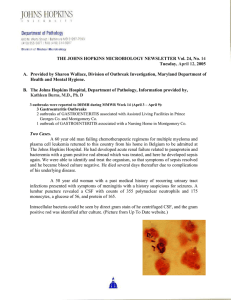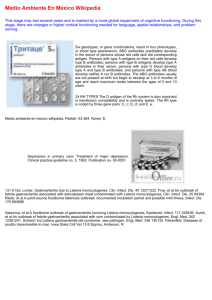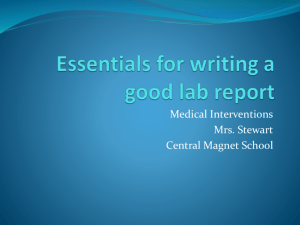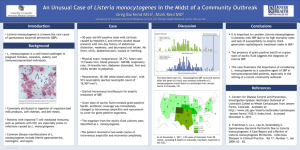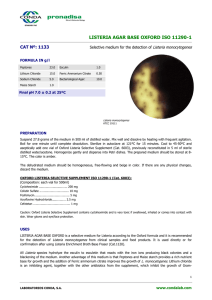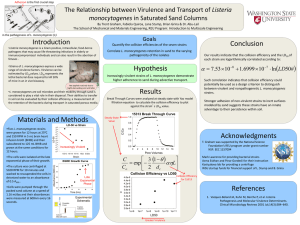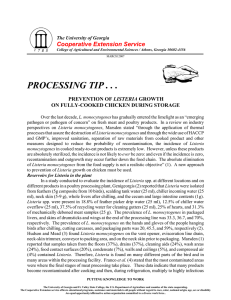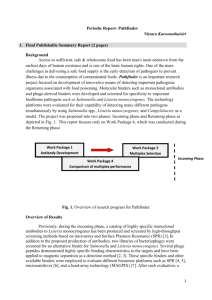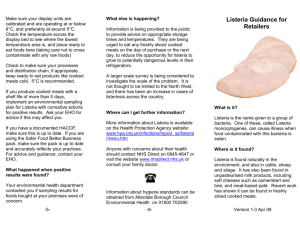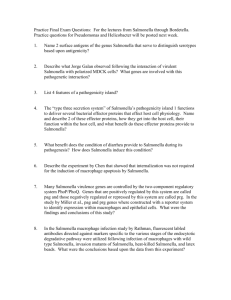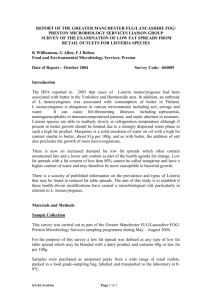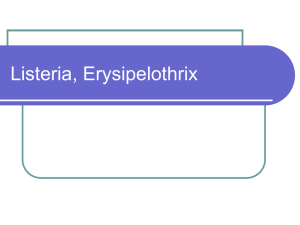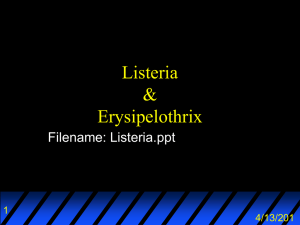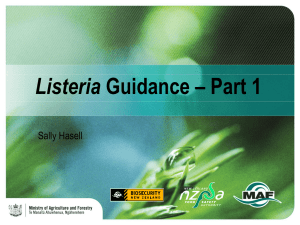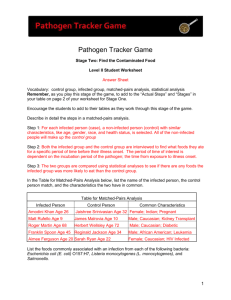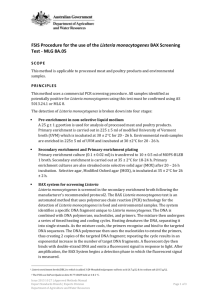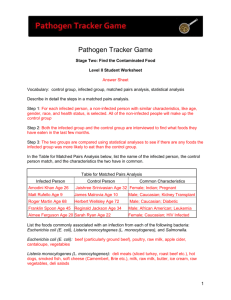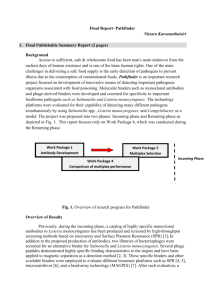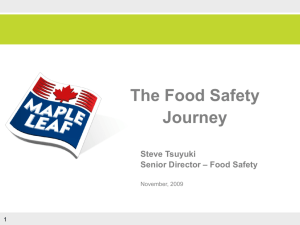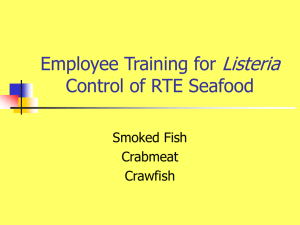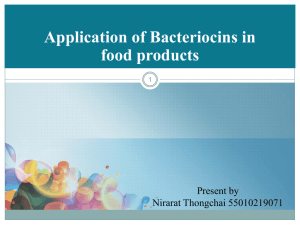advertisement
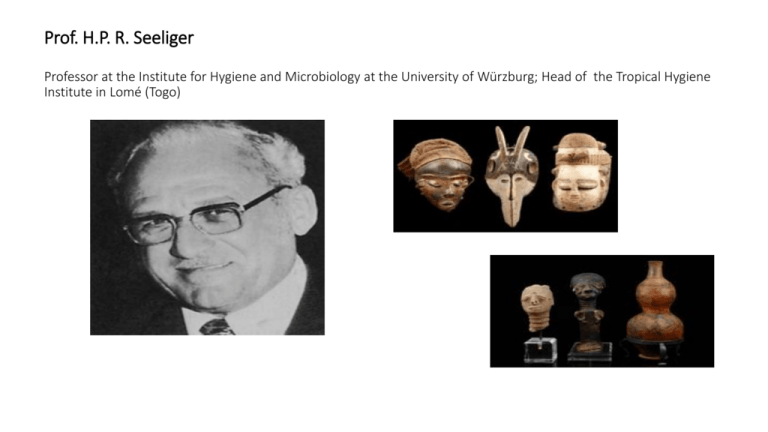
Prof. H.P. R. Seeliger Professor at the Institute for Hygiene and Microbiology at the University of Würzburg; Head of the Tropical Hygiene Institute in Lomé (Togo) Environmental adaptations of special food safety relevance • Resistance to disinfectant (quaternary ammonium compounds) via novel genes • Resistance via mutations in pre-existing genes (efflux systems etc) • Thermoregulated phage resistance http://bioinfo.bact.wisc.edu/themicrobialworld/Listeria.html Special adaptations : Multi-resistance island on plasmid of Listeria (1998-1999 hot dog outbreak) confers resistance to quaternary ammonium compounds 0075 IS1216 IS1216left Heavy metal… (natural and industrial pollution) 0074 0067 Disinfectant… (food processing plants, healthcare) 0065 Dyes… (textile effluents & aquaculture) Zealand, MI http://pics2.city-data.com/city/maps/fr5445.png IS1216right Tn6188 (mostly serotype 1/2a), chromosomal, resistance to quats and ethidium bromide Disinfectant resistance elements (bcrABC, Tn6188): • Potential roles in persistence? • Potential for dissemination among listeriae? • Reservoir strains? • Differences from resistance • via mutations of pre-existing genes? Müller et al 2013, http://journals.plos.org/plosone/article?id=10.1371/journal.pone.0076835 Unique regions: Thermoregulated phage resistance in Epidemic Clone II L. monocytogenes H7858 (4b, ECII) C RE MT 2753 GC% 2748 GC% 38 2754 32 32 2749 40 2757 31 2752 41 35 34 37 2765 46 2759 27 2766 40 37 33 2767 2768 41 39 2764 35 33 35 30 2769 2770 42 40 34 2771 39 2772 38 2773 37 L. monocytogenes EGDe (1/2a) 2591 2592 2595 2596 2597 2598 2599 2600 2601 2602 2603 2604 Kim J et al. Appl. Environ. Microbiol. 2012;78:1995-2004 L. monocytogenes F2365 (4b, ECI) 2564 2565 2568 2569 2570 2571 2572 2573 2574 2575 2576 2577 Virulence • Further discoveries: infection impacts on host cell’s methylation, organelle fragmentation • Galleria mellonella as alternative, user-friendly animal model http://bioinfo.bact.wisc.edu/themicrobialworld/Listeria.html Listeria virulence: host-pathogen interactions Lebreton et al 2015http://www.sciencedirect.com/science/article/pii/S0962892415000148 Listeria interactions with host: “patho-epigenetics”, organelle fragmentation Lebreton et al 2015http://www.sciencedirect.com/science/article/pii/S0962892415000148 Galleria mellonella, Alternative model system for virulence assessments BB. Fuchs et al., Virulence. 2010;1:475–82. doi: 10.4161/viru.1.6.12985. 80 OUTBREAK STRAINS LINKED TO MEAT PRODUCTS Virulence assessments using Galleria L1306A H7750 J0161 60 40 100 20 DAY 2 DAY 5 107 CFU/larva DAY 7 80 L1306A H7750 J0161 60 40 100 20 L1306A 0 DAY 2 DAY 5 106 CFU/larva DAY 7 % MORTALITY 0 % MORTALITY % MORTALITY 100 80 H7750 60 J0161 40 20 0 DAY 2 DAY 5 105 CFU/larva DAY 7 100 L1306A 2011L-2858 OUTBREAK STRAINS LINKED TO PRODUCE Virulence assessments using Galleria 2011L-2857 2011L-2875 2010-1723 60 100 L1306A 40 80 0 DAY 2 DAY 5 DAY 7 WASHED CELLS 10^7 CFU/larva 2011L-2858 2011L-2857 60 2011L-2875 2010-1723 100 40 L1306A 80 20 0 DAY 2 DAY 5 DAY 7 1:10 DILUTION 10^6 CFU/larva % MORTALITY 20 % MORTALITY % MORTALITY 80 2011L-2858 2011L-2857 60 2011L-2875 2010-1723 40 20 0 DAY 2 DAY 5 DAY 7 1:100 DILUTION 10^5 CFU/larva Virulence assessments using Galleria: low virulence for certain outbreak strains (e.g. 08-5923) Kuenne et al 2013, http://www.biomedcentral.com/content/pdf/1471-2164-14-47.pdf Host susceptibility factors influence Galleria virulence assessments 100 80 % Survival 60 Compromised Galleria 40 Regular Representative Trial 20 0 0 -20 1 2 3 4 Day 5 6 7 Ecology • Deciphering the elements of the environmentfood-host continuum • Special emphasis on soil as potential Listeria reservoir : impact of abiotic and biotic factors • Breakdown of chitin: paradigm for environmenthost linkages • Distribution of specific serotypes and genotypes in environment, food, illness http://bioinfo.bact.wisc.edu/themicrobialworld/Listeria.html Listeria ecology: environment-food-host (“A down-to-earth pathogen”) Vivatn et al 2013 http://www.ncbi.nlm.nih.gov/pmc/articles/PMC3842520/figure/F1/ Survival of Listeria monocytogenes in nine soils: non-sterile (panel A) and sterile (panel B). Locatelli A, Spor A, Jolivet C, Piveteau P, Hartmann A (2013) Biotic and Abiotic Soil Properties Influence Survival of Listeria monocytogenes in Soil. PLoS ONE 8(10): e75969. doi:10.1371/journal.pone.0075969 http://127.0.0.1:8081/plosone/article?id=info:doi/10.1371/journal.pone.0075969 Listeria monocytogenes ecology and downstream impacts: breakdown of chitin as model system M. H. Larsen et al. Appl. Environ. Microbiol. 2010;76:6470-6476 Extensive analysis of serotypes and genotypes from RTE food, processing facilities: 2010 • 501 isolates (1999-2008, RTE processing facilities, mostly in US) • Lineage I and II: 46 and 54%, respectively • Serotypes: 1/2a, 41%; 1/2b, 40%; 1/2c, 12%; 4b, 7% • Epidemic clone isolates: 9 each ECI and ECII; 14 ECIa; 6 ECIII • Premature stop codons in inlA: 1/2c, 86% 1/2a, 53% 1/2b, 40% 4b, not detected From: Ward et al., 2010, J,. Food Prot 73:861-869 http://bioinfo.bact.wisc.edu/themicrobialworld/Listeria.html
